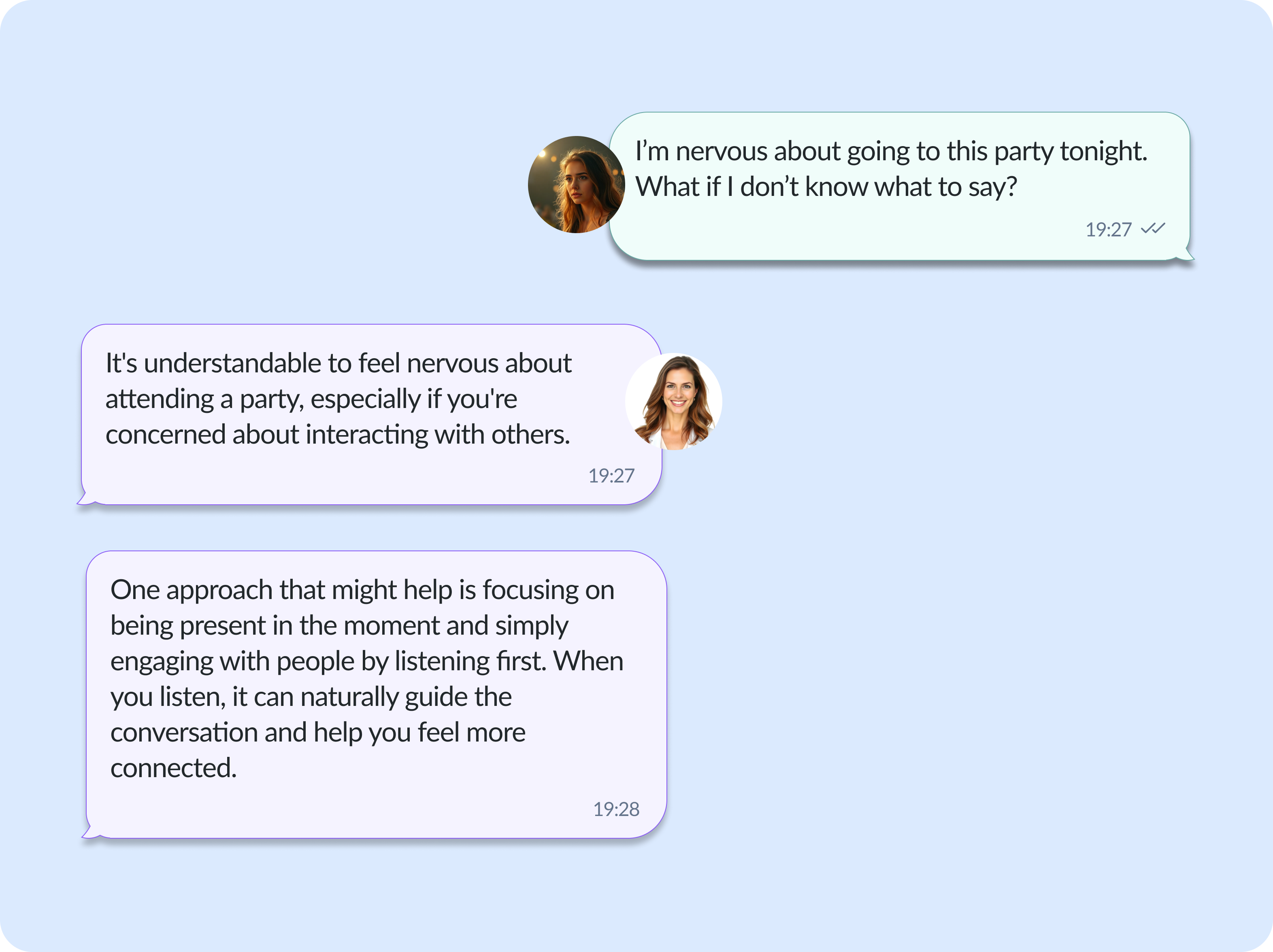Anxiety

Social anxiety can be more than just feeling shy or awkward—it’s an overwhelming fear of social situations that many people face every day. Whether it’s a work event, a casual get-together, or even just meeting new people, social anxiety can make you feel trapped, isolated, and exhausted. The good news? You’re not alone, and there are practical ways to manage these feelings. In this article, we’ll explore simple strategies to help you calm your nerves, feel more confident in social settings, and take control of your anxiety.
Picture this: Sarah has been invited to her friend Paula’s birthday party, and at first, she was excited to go. But as the day gets closer, that excitement turns into anxiety. Sarah can’t stop thinking about how she doesn’t know many people who will be there. She imagines herself standing awkwardly in a corner, not knowing what to say or how to join in on conversations. Her mind starts racing with all the worst-case scenarios: What if she says something embarrassing? What if no one talks to her, or worse, what if they think she’s boring?
As these thoughts swirl, Sarah feels the familiar signs of social anxiety creeping in—her chest tightens, her palms get sweaty, and she starts considering making up an excuse to avoid going altogether. But this time, Sarah decides to try something different. Instead of canceling, she uses a few strategies that she talked about with Wendy to manage her anxiety.
Here’s what Sarah did, and what you can try too.
When Sarah first felt her anxiety rising before the party, she remembered a simple but powerful tool: deep breathing. By focusing on her breath, she calmed her nervous system and managed to slow down her racing thoughts.
Try this: When you feel anxiety building before a social event, take five slow, deep breaths. Inhale through your nose for a count of four, hold for four, and exhale through your mouth for a count of six. This helps your body relax and reduces the physical symptoms of anxiety, like a racing heart.
Why this works: Deep breathing activates the body’s parasympathetic nervous system, which helps you relax by slowing your heart rate and reducing physical tension. This shift from “fight-or-flight” mode to a calmer state allows your body to release anxiety.
Part of Sarah’s anxiety came from feeling unprepared. What if she didn’t know what to say or how to start a conversation? To ease this worry, Sarah spent some time preparing. She chose an outfit that made her feel confident, and she mentally rehearsed a few simple conversation starters she could use when meeting new people.
Try this: If you’re nervous about talking to people, think of a few topics in advance. Simple questions like, “How do you know Paula?” or “What do you do for work?” are great icebreakers. Having these ready can make you feel more in control when you arrive.
Why this works: Deep breathing activates the body’s parasympathetic nervous system, which helps you relax by slowing your heart rate and reducing physical tension. This shift from “fight-or-flight” mode to a calmer state allows your body to release anxiety.
At the party, Sarah’s first instinct was to worry about how she’d be perceived—what if people didn’t like her or thought she was awkward? But instead of focusing on her own insecurities, Sarah made a conscious effort to shift her attention to the people around her. She asked questions and showed genuine interest in their stories.
Try this: If social anxiety has you feeling self-conscious, focus on others instead. Ask questions, listen, and get curious about their experiences. This not only makes you feel less in the spotlight, but it also helps build stronger connections.
Why this works: Social anxiety often comes from an excessive focus on yourself. By directing your attention to others, you break the cycle of self-consciousness and create more meaningful connections, which helps you feel more comfortable in social settings.
As Sarah walked into the party, her mind filled with negative thoughts like, “I’m going to embarrass myself” or “No one will want to talk to me.” But instead of letting these thoughts control her, Sarah challenged them. She asked herself, “Is this really true?” and reminded herself that most people are too focused on their own experiences to judge her.
Try this: When negative thoughts pop up, ask yourself whether they are based on facts or assumptions. Replace the thought, “Everyone will think I’m awkward” with something more balanced, like, “Most people won’t even notice if I’m nervous.”
Why this works: Cognitive-behavioral therapy (CBT) techniques like challenging negative thoughts help reframe distorted thinking. By questioning whether your fears are based on reality, you can replace irrational thoughts with more balanced and realistic ones.
Before leaving for the party, Sarah spent a few minutes picturing herself having a good time. She imagined smiling, chatting with people, and feeling comfortable in the group. This simple visualization exercise helped her feel more confident as she walked into the event.
Try this: Visualization is a powerful tool. Before your next social event, close your eyes and imagine yourself thriving in the situation—laughing, talking, and feeling at ease. This mental practice can help reduce anxiety and build your confidence.
Why this works: Visualization primes your brain for success by mentally rehearsing positive outcomes. This can reduce your anxiety by helping you feel more prepared and optimistic.
Instead of diving straight into a big group conversation, Sarah started small. She found her friend first and chatted with her for a few minutes before gradually introducing herself to other guests. By starting with a familiar face, Sarah was able to ease into the social setting without feeling overwhelmed.
Try this: If large groups feel too intimidating, start small. Chat with someone you already know or approach one person at a time. Slowly, you’ll build confidence and feel more comfortable engaging with the rest of the group.
Why this works: Gradual exposure to anxiety-inducing situations helps you build confidence over time. Starting small reduces the pressure and gives you the opportunity to practice your social skills in manageable doses.
In the days leading up to the party, Sarah started to feel overwhelmed by her anxiety. That’s when she decided to turn to Wendy for support. Wendy had been helpful for Sarah before, and she knew she could rely on it for practical advice and reassurance.
Before the party, Sarah sent a quick message to Wendy:

Thanks to these strategies, Sarah not only attended the party but ended up enjoying herself. She didn’t have a perfect night—there were still moments when she felt awkward—but she felt proud for pushing through her anxiety. By practicing deep breathing, shifting her focus, and challenging her negative thoughts, Sarah made it through the evening without letting her social anxiety take control.
Managing social anxiety isn’t about eliminating anxiety altogether—it’s about learning to navigate it and build confidence over time. By practicing techniques like deep breathing, challenging negative thoughts, and visualizing success, you can take small steps toward feeling more at ease in social settings.
And when you need extra support, Wendy is always there to guide you through. Remember, progress is about small victories, and with the right tools, you can thrive in social situations, just like Sarah did.
Talk to Wendy - try 5 days for free